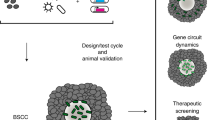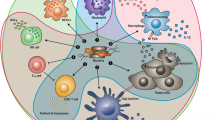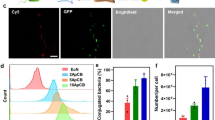Abstract
Motile bacteria can overcome diffusion resistances that substantially reduce the efficacy of standard cancer therapies. Many reports have also recently described the ability of Salmonella to deliver therapeutic molecules to tumors. Despite this potential, little is known about the spatiotemporal dynamics of bacterial accumulation in solid tumors. Ultimately this timing will affect how these microbes are used therapeutically. To determine how bacteria localize, we intravenously injected Salmonella typhimurium into BALB/c mice with 4T1 mammary carcinoma and measured the average bacterial content as a function of time. Immunohistochemistry was used to measure the extent of apoptosis, the average distance of bacteria from tumor vasculature and the location of bacteria in four different regions: the core, transition, body and edge. Bacteria accumulation was also measured in pulmonary and hepatic metastases. The doubling time of bacterial colonies in tumors was measured to be 16.8 h, and colonization was determined to delay tumor growth by 48 h. From 12 and 48 h after injection, the average distance between bacterial colonies and functional vasculature significantly increased from 130 to 310 μm. After 48 h, bacteria migrated away from the tumor edge toward the central core and induced apoptosis. After 96 h, bacteria began to marginate to the tumor transition zone. All observed metastases contained Salmonella and the extent of bacterial colocalization with metastatic tissue was 44% compared with 0.5% with normal liver parenchyma. These results demonstrate that Salmonella can penetrate tumor tissue and can selectively target metastases, two critical characteristics of a targeted cancer therapeutic.
This is a preview of subscription content, access via your institution
Access options
Subscribe to this journal
Receive 12 print issues and online access
$259.00 per year
only $21.58 per issue
Buy this article
- Purchase on Springer Link
- Instant access to full article PDF
Prices may be subject to local taxes which are calculated during checkout






Similar content being viewed by others
References
Sporn MB . The war on cancer. Lancet 1996; 347: 1377–1381.
Cairns R, Papandreou I, Denko N . Overcoming physiologic barriers to cancer treatment by molecularly targeting the tumor microenvironment. Mol Cancer Res 2006; 4: 61–70.
Jain RK, Forbes NS . Can engineered bacteria help control cancer? Proc Natl Acad Sci USA 2001; 98: 14748–14750.
Minchinton AI, Tannock IF . Drug penetration in solid tumours. Nat Rev Cancer 2006; 6: 583–592.
Albini A, Sporn MB . The tumour microenvironment as a target for chemoprevention. Nat Rev Cancer 2007; 7: 139–147.
Sung SY, Hsieh CL, Wu D, Chung LW, Johnstone PA . Tumor microenvironment promotes cancer progression, metastasis, and therapeutic resistance. Curr Probl Cancer 2007; 31: 36–100.
Graeber TG, Osmanian C, Jacks T, Housman DE, Koch CJ, Lowe SW et al. Hypoxia-mediated selection of cells with diminished apoptotic potential in solid tumours. Nature 1996; 379: 88–91.
Vaupel P, Harrison L . Tumor hypoxia: causative factors, compensatory mechanisms, and cellular response. Oncologist 2004; 9 (Suppl 5): 4–9.
Yu JL, Rak JW, Coomber BL, Hicklin DJ, Kerbel RS . Effect of p53 status on tumor response to antiangiogenic therapy. Science 2002; 295: 1526–1528.
Bustuoabad OD, Ruggiero RA, di Gianni P, Lombardi MG, Belli C, Camerano GV et al. Tumor transition zone: a putative new morphological and functional hallmark of tumor aggressiveness. Oncol Res 2005; 15: 169–182.
Ganai S, Arenas RB, Forbes NS . Tumour-targeted delivery of TRAIL using Salmonella typhimurium enhances breast cancer survival in mice. Br J Cancer 2009; 101: 1683–1691.
Jiang SN, Phan TX, Nam TK, Nguyen VH, Kim HS, Bom HS et al. Inhibition of Tumor Growth and Metastasis by a Combination of Escherichia coli-mediated Cytolytic Therapy and Radiotherapy. Mol Ther 2010; 18: 635–642.
Loeffler M, Le’Negrate G, Krajewska M, Reed JC . Inhibition of tumor growth using salmonella expressing Fas ligand. J Natl Cancer Inst 2008; 100: 1113–1116.
Ryan RM, Green J, Williams PJ, Tazzyman S, Hunt S, Harmey JH et al. Bacterial delivery of a novel cytolysin to hypoxic areas of solid tumors. Gene Ther 2009; 16: 329–339.
Clairmont C, Lee KC, Pike J, Ittensohn M, Low KB, Pawelek J et al. Biodistribution and genetic stability of the novel antitumor agent VNP20009, a genetically modified strain of Salmonella typhimurium. J Infect Dis 2000; 181: 1996–2002.
Forbes NS, Munn LL, Fukumura D, Jain RK . Sparse initial entrapment of systemically injected Salmonella typhimurium leads to heterogeneous accumulation within tumors. Cancer Res 2003; 63: 5188–5193.
Zhao M, Yang M, Li XM, Jiang P, Baranov E, Li S et al. Tumor-targeting bacterial therapy with amino acid auxotrophs of GFP-expressing Salmonella typhimurium. Proc Natl Acad Sci USA 2005; 102: 755–760.
Zhao M, Yang M, Ma H, Li X, Tan X, Li S et al. Targeted therapy with a Salmonella typhimurium leucine-arginine auxotroph cures orthotopic human breast tumors in nude mice. Cancer Res 2006; 66: 7647–7652.
Sznol M, Lin SL, Bermudes D, Zheng LM, King I . Use of preferentially replicating bacteria for the treatment of cancer. J Clin Invest 2000; 105: 1027–1030.
Yu YA, Shabahang S, Timiryasova TM, Zhang Q, Beltz R, Gentschev I et al. Visualization of tumors and metastases in live animals with bacteria and vaccinia virus encoding light-emitting proteins. Nat Biotechnol 2004; 22: 313–320.
Stritzker J, Weibel S, Hill PJ, Oelschlaeger TA, Goebel W, Szalay AA . Tumor-specific colonization, tissue distribution, and gene induction by probiotic Escherichia coli Nissle 1917 in live mice. Int J Med Microbiol 2007; 297: 151–162.
Kasinskas RW, Forbes NS . Salmonella typhimurium specifically chemotax and proliferate in heterogeneous tumor tissue in vitro. Biotechnol Bioeng 2006; 94: 710–721.
Kasinskas RW, Forbes NS . Salmonella typhimurium lacking ribose chemoreceptors localize in tumor quiescence and induce apoptosis. Cancer Res 2007; 67: 3201–3209.
Heimann DM, Rosenberg SA . Continuous intravenous administration of live genetically modified salmonella typhimurium in patients with metastatic melanoma. J Immunother 2003; 26: 179–180.
Toso JF, Gill VJ, Hwu P, Marincola FM, Restifo NP, Schwartzentruber DJ et al. Phase I study of the intravenous administration of attenuated Salmonella typhimurium to patients with metastatic melanoma. J Clin Oncol 2002; 20: 142–152.
Yoneda T, Michigami T, Yi B, Williams PJ, Niewolna M, Hiraga T . Actions of bisphosphonate on bone metastasis in animal models of breast carcinoma. Cancer 2000; 88 (12 Suppl): 2979–2988.
Cole III TM, Richtsmeier JT . A simple method for visualization of influential landmarks when using euclidean distance matrix analysis. Am J Phys Anthropol 1998; 107: 273–283.
Wong CW, Song C, Grimes MM, Fu W, Dewhirst MW, Muschel RJ et al. Intravascular location of breast cancer cells after spontaneous metastasis to the lung. Am J Pathol 2002; 161: 749–753.
Pawelek JM, Low KB, Bermudes D . Tumor-targeted Salmonella as a novel anticancer vector. Cancer Res 1997; 57: 4537–4544.
Low KB, Ittensohn M, Le T, Platt J, Sodi S, Amoss M et al. Lipid A mutant Salmonella with suppressed virulence and TNFalpha induction retain tumor-targeting in vivo. Nat Biotechnol 1999; 17: 37–41.
Kim BJ, Forbes NS . Single-cell analysis demonstrates how nutrient deprivation creates apoptotic and quiescent cell populations in tumor cylindroids. Biotechnol Bioeng 2008; 101: 797–810.
Rosenberg SA, Spiess PJ, Kleiner DE . Antitumor effects in mice of the intravenous injection of attenuated Salmonella typhimurium. J Immunother 2002; 25: 218–225.
Lee CH, Wu CL, Shiau AL . Salmonella choleraesuis as an anticancer agent in a syngeneic model of orthotopic hepatocellular carcinoma. Int J Cancer 2008; 122: 930–935.
Zheng LM, Luo X, Feng M, Li ZJ, Le T, Ittensohn M et al. Tumor amplified protein expression therapy: Salmonella as a tumor-selective protein delivery vector. Oncol Res 2000; 12: 127–135.
Forbes NS . Profile of a bacterial tumor killer. Nat Biotechnol 2006; 24: 1484–1485.
Acknowledgements
We gratefully acknowledge financial support from the National Institutes of Health (Grant No. 1R01CA120825-01A1), Susan G. Komen for the Cure (Grant No. BCTR0601001) and the Collaborative Biomedical Research Program at the University of Massachusetts, Amherst. We thank Richard B. Wait, and the Department of Surgery at Baystate Medical Center for the grant and materials support for SG. The Salmonella typhimurium strain VNP20009 was kindly provided by Vion Pharmaceuticals (New Haven, CT).
Author information
Authors and Affiliations
Corresponding author
Ethics declarations
Competing interests
The authors declare no conflict of interest.
Rights and permissions
About this article
Cite this article
Ganai, S., Arenas, R., Sauer, J. et al. In tumors Salmonella migrate away from vasculature toward the transition zone and induce apoptosis. Cancer Gene Ther 18, 457–466 (2011). https://doi.org/10.1038/cgt.2011.10
Received:
Revised:
Accepted:
Published:
Issue Date:
DOI: https://doi.org/10.1038/cgt.2011.10
Keywords
This article is cited by
-
Engineering the gut microbiome
Nature Reviews Bioengineering (2023)
-
Current advances in microbial-based cancer therapies
Medical Oncology (2023)
-
Bacterial Peptides and Bacteriocins as Novel Treatment for Prostate Cancer
International Journal of Peptide Research and Therapeutics (2023)
-
Nanotechnology-based cell-mediated delivery systems for cancer therapy and diagnosis
Drug Delivery and Translational Research (2023)
-
Streptococcal bacterial components in cancer therapy
Cancer Gene Therapy (2022)



